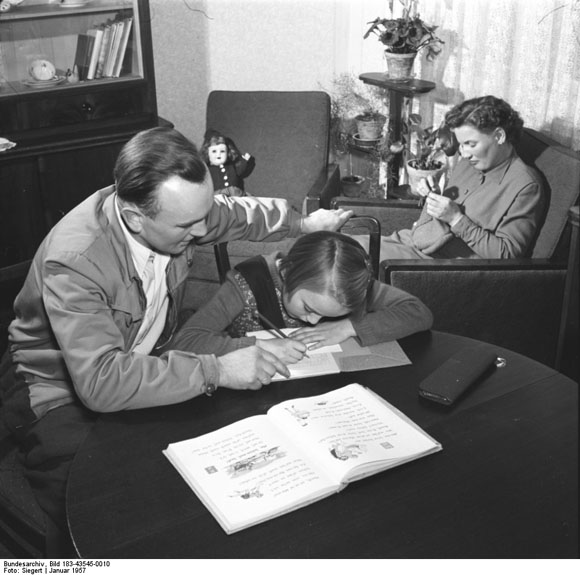Source

Source: Photograph, 1957. Photographer: Siegert. © Bundesarchiv Bild 183-43545-0010
In the German Democratic Republic, in contrast to the Federal Republic, the subjects of flight and expulsion were suppressed in the public discourse. In SED diction, refugees and expellees were called “resettlers;” and expellee organizations were forbidden as revanchist. Nonetheless, the SED government passed a socio-politically oriented “Resettler Law,” which remained in effect until 1953 and offered financial assistance to resettlers. Despite this, resettlers were still more likely to experience pressure to assimilate than actual integration. Additionally, on account of their frequently critical attitude toward the Soviet Union, ethnic German refugees and expellees from Eastern Europe were often subject to surveillance by the East German Ministry for State Security [Stasi].
GDR propaganda sought to counter this reality with “success stories” such as the one featured below. This photo was commissioned by the East German government's picture agency, Zentralbild, which supplied all GDR media with image material. The original caption reads: “Resettlers from the Czechoslovak Socialist Republic find a new homeland in the GDR. In stark contrast to the Adenauer government, where politicians without any conscience do everything possible to keep the living standard of the resettlers as low as possible, in order to misuse them for their revanchist policies, the GDR government constantly strives to give these people a new homeland. A few years ago, Erhard Schmidt, now 28 years old, moved from the Czechoslovak Socialist Republic to the GDR to work in agriculture. In 1950, he started his work as a compliance assistant in the Riesa steelworks, and later he passed his examination as a professional steel roller. He was able to achieve this goal by attending company-sponsored adult education classes. His good work and reliable nature then helped him attain the position of supervisor. In recognition of his numerous suggestions for improvements, he has already been decorated as an “activist” twice. In this way, the former resettler, who lives with his family in a house with a garden in the workers’ housing association, found a new homeland and a secure livelihood in the German Democratic Republic. In the photograph: in the evenings, Erhard Schmidt often helps his daughter Elvira with her homework.”

Source: Photograph, 1957. Photographer: Siegert. © Bundesarchiv Bild 183-43545-0010